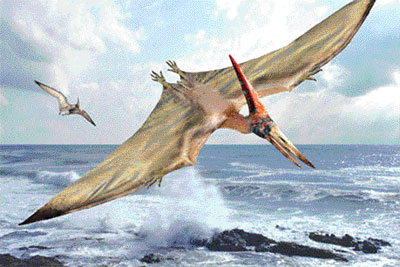|

Flying reptile
fossil found in Texas
Fossilized bones discovered in Texas from a flying reptile that died
89 million years ago may be the earliest occurrence of the prehistoric
creature known as Pteranodon.
Previously,Pteranodon bones have been found in Kansas, South Dakota
and Wyoming in the Niobrara and Pierre geological formations. This
likely Pteranodon specimen is the first of its kind found in Texas,
according to paleontologist Timothy S. Myers at Southern Methodist
University in Dallas, who identified the reptile.

The specimen was discovered north of Dallas by an amateur fossil
hunter who found various bones belonging to the left wing.
Pteranodon was a type of pterosaur that lived about the same time as
some dinosaurs, about 100 million to 65 million years ago.
The only reptiles to dominate the ancient skies, pterosaurs had broad
leathery wings and slim torsos.
The specimen identified by Myers is an adult pterosaur of the
toothless variety and while larger than most birds, wasn't among the
largest pterosaurs, Myers said, noting it had a wing span between 12 and
13 feet, or 3.6 to 4 metres. It was discovered in the Austin Group, a
prominent rock unit in Texas that was deposited around 89 million years
ago, early in the geological time period called the Late Cretaceous.
Pterosaurs, many of which survived on fish, lived at a time when a
massive ancient sea cut across the central United States.
The Western Interior Seaway was a shallow body of water that split
North America in half from the Arctic Ocean to the Gulf of Mexico.More
than a thousand Pteranodon fossils have been unearthed from the middle
part of the seaway.No definitive Pteranodon specimens have emerged from
the southern part that is now Texas.
The SMU specimen, if it is Pteranodon, would be the first discovered
so far south in the Western Interior Seaway, said Myers,
Key to identifying the SMU fossils as Pteranodon is a humerus of 5.7
inches, or 14.5 centimeters. The humerus is the uppermost bone in the
wing and attaches to the torso. The humerus of the SMU specimen, while
complete, did suffer some damage during fossilization when it became
compressed and distorted through millions of years of compaction.
"If it wasn't crushed so badly, it would be possible to determine if
it really is Pteranodon," Myers said. "'While it's difficult to narrow
the humerus definitively to a specific genus and species, some features
clearly identify the specimen as part of the Pteranodontidae family,
most likely the genus Pteranodon. Discovered along with the humerus were
parts of the elongated fourth finger that in pterosaurs forms the wing.
The fossils do not solve the mystery of the reptile's cause of death,
Myers said. But it appears the animal probably died in flight over the
sea and then fell into the water. If the specimen represents Pteranodon,
Myers said, it would be the oldest one in North America by a million to
two million years, and the second oldest pteranodontid in the world.
Courtesy: Science Daily |

